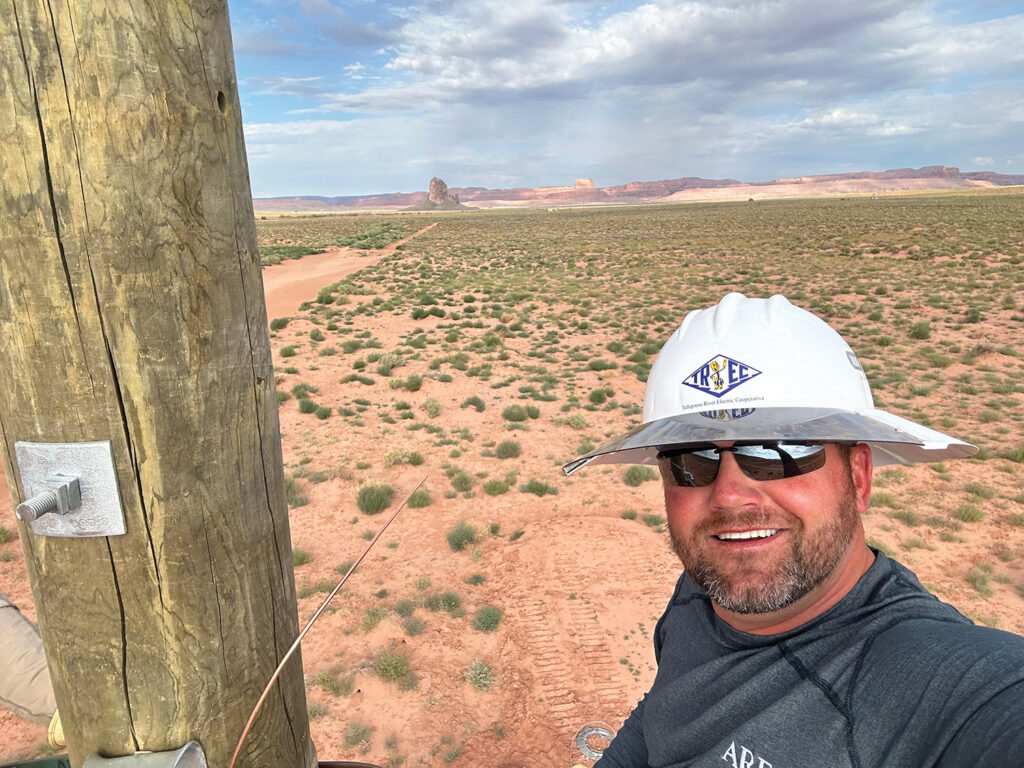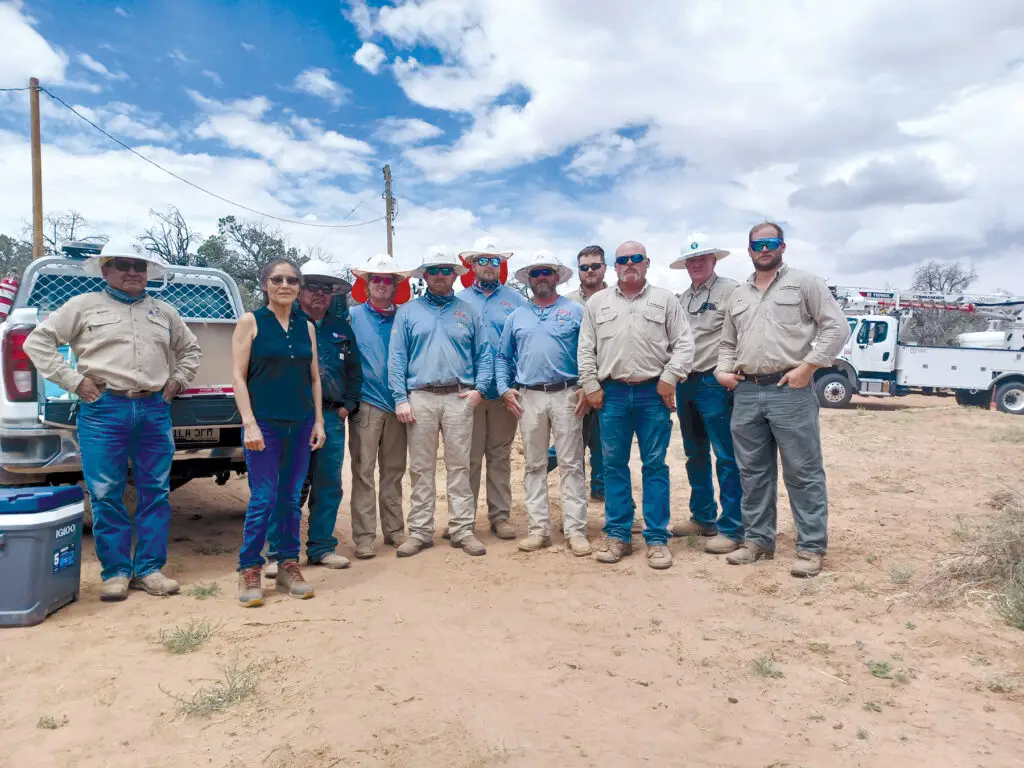Co-ops work together to bring electricity to Navajo lands
By Allison Law
America’s rural electric cooperatives have worked to bring safe, reliable electricity to their members for nearly 100 years. Bringing power to rural areas in developing countries – places like Guatemala, Bolivia and the African continent – is a natural extension of the cooperative model.
But there are people in the United States – a prosperous nation with significant natural resources – who even today still do not have electricity.
Two of Alabama’s co-ops traveled to the rural desert Southwest in July to participate in Light Up Navajo, a mutual aid training project launched in 2019 to connect homes to the electric grid. Each year, utilities from across the country send electric crews to the Navajo Nation to build power lines and help connect homes.
Each co-op sent one four-man crew to a remote area in the Kayenta township in the Navajo Nation in Arizona, about 25 miles south of Monument Valley and the Utah state line. The territory of the Navajo Nation is vast: 27,000 square miles, or roughly the size of West Virginia. Joe Wheeler EMC, based in Trinity, and Dixie EC, based in Montgomery, became the first Alabama co-ops to participate in Light Up Navajo.
Also on the trip was Chad Smith, statewide safety specialist for the Alabama Rural Electric Association (AREA), which publishes Alabama Living. Smith was the safety representative and documentarian for the trip, and previously worked as a lineman for 11 years.

Linemen are accustomed to doing storm work – traveling to areas hit hard by natural disasters and working with the local electric cooperative to help bring people back online and turn the lights on. But this project, Smith says, was different. Its remote location on a Navajo reservation, and the low density of customers, meant that progress, while tangible, seemed incredibly slow.
After a hurricane, when a visiting co-op crew begins working, “you can work two to three days and get hundreds or thousands of people on,” Smith says. “The whole time we worked (in Arizona), I think we turned on seven meters.”
There are still 13,000 households on the Navajo reservation that do not have electricity. But the homes are so far apart, a crew might build 10 miles of line and connect only two homes to the grid.

Generations of poverty
As much as he was struck by the natural beauty of the area – Smith’s phone is crammed full with photos he took there – what made the biggest impression on him was the poverty.
The unemployment rate there is more than 14.6%, and 37% of the Navajo people live below the poverty line.
“A lot of the people on the reservation basically are surviving,” Smith says, and not really living. With no refrigeration, families only buy the refrigerated food they can consume in a day; everything else will spoil by the next day. Coolers can help, but with heat in the 100-plus range in the summer, the ice melts quickly.
The remoteness of the area means a lot of traveling for things most Americans take for granted. Going to a store can mean a two-hour drive one way. Children might have to get up by 5 a.m. to be driven to a bus stop an hour away, and then still have to be bused to school. They might not get home till after 7 p.m. and do homework by candles or flashlights.
Without electricity to run water pumps – water is already a scarce commodity in the desert – the residents carry water tanks on the backs of vehicles to fill up, a trip that can be an hour or more.

The families, Smith says, are usually multi-generational and live in small dwellings and cook over fire. Once the home gets power, part of the family will move and build nearby, waiting their turn for power. The cycle seems never-ending.
Those who do receive power, Smith says, are grateful for even the smallest things. One family spoke at the project’s closing dinner, a way for the locals to say “thank you” to the visiting linemen. The family said the first night they received power, the whole family sat around a fan. They stayed up late, amazed that they didn’t have to turn off the fan and the generator that powered it.
‘There goes our help’
Light Up Navajo is coordinated by the Navajo Tribal Utility Authority. The authority is a not-for-profit enterprise of the Navajo Nation that provides utility services on reservation lands, primarily in the four corners area of Utah, Colorado, Arizona and New Mexico. The authority is responsible for maintaining the lines after the visiting crews leave.
The Light Up Navajo project, which runs from April through July each year, is a tremendous help to the authority, which must spend $40,000 to build enough miles of primary power lines to bring electricity to a single home in a remote area. Walter Haase, general manager of the utility, says the contributions of the manpower as well as materials allows the authority to spread its dollars further.
The biggest impact, Haase says, can be seen in the daily lives of the people who are finally enjoying the benefits of electricity.
“You’ve got refrigeration for the first time, which is huge,” he says. “You’re able to cook and heat your home without having to burn coal and wood. … Having electricity erases the worry. It gives people more time in their lives … It’s a gift that all Americans deserve.”

Though the nation’s rural electric cooperatives usually help other sister co-ops in times of a disaster, the Light Up Navajo project is a coordinated effort of co-ops as well as public power utilities and investor-owned utilities. The traveling teams this year were from Alabama, Arizona, California, Colorado, Connecticut, Delaware, Massachusetts, New Mexico, North Carolina, Ohio, Oklahoma, Oregon, Utah, Texas, Washington and Wisconsin.
The authority is grateful for the help of the visiting crews, and saying goodbye to them is difficult, Smith says.
The manager of their district told the Alabama crews that every year, the Light Up Navajo project is bittersweet. “At the beginning (of the project) we’re excited and by the end, we’re sad,” Smith recalls the manager saying, “because I see all of y’all leaving, and there went our help until next year.”
Knowing they’ve made a difference, even for just a few households, makes the work and long travel worth it, Smith says. “This is one of the highlights of my career, as far as helping people,” he says.
Information from the National Rural Electric Cooperative Association (NRECA) contributed to this report.
The linemen who participated in the project:
Dixie EC: Caleb Duncan, Cody Snell, Ethan Ray and Josh Shreffler
Joe Wheeler EMC: Kenneth Hanvy, Jeremy Henderson, Drew Parker and Ben McLemore




